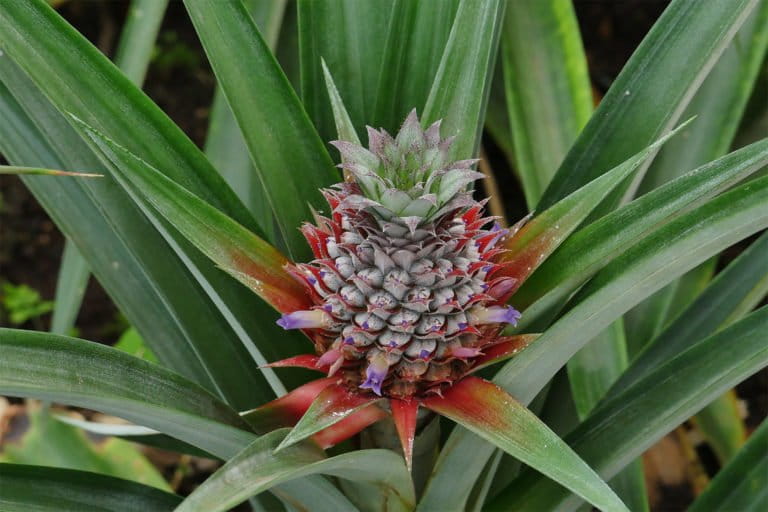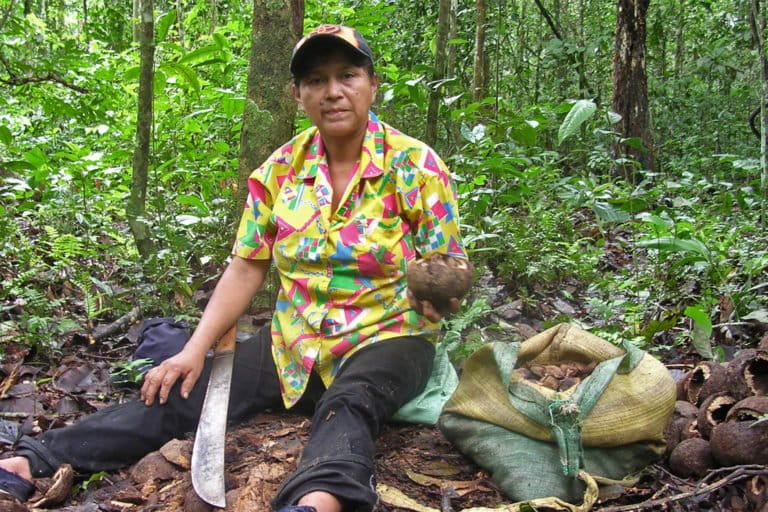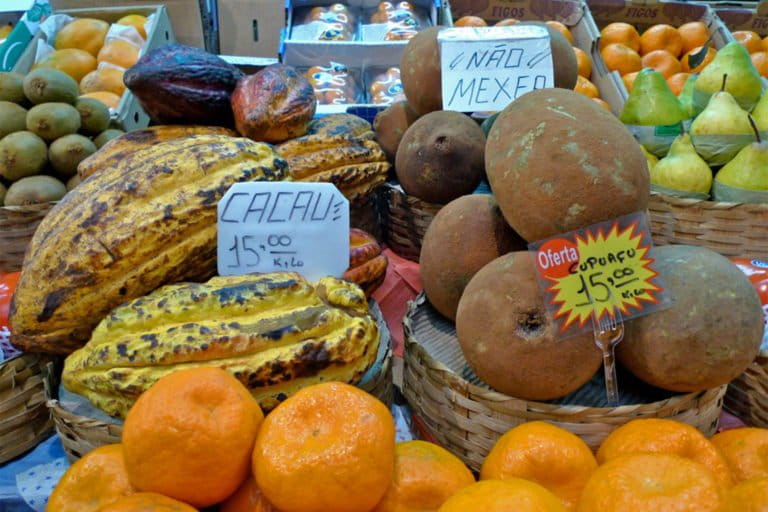- Brazil may have given its name to the Brazil nut, but it exports less than 6% of the global export market of the nut, while Bolivia supplies 52%.
- That’s one of several key findings from new research that shows that Brazil, home to a third of all tropical forests, is punching well below its own weight when it comes to the value of its exports of forest-derived commodities.
- Experts highlight several key obstacles preventing production and export of these commodities from being scaled up, including logistics, lack of technical expertise and equipment, and costly certification requirements for breaking into markets like the EU.
- Proponents say ramping up production and exports of forest commodities could be the key to achieving economic and social development in the Brazilian Amazon, as well as a way of reviving vast swaths of degraded and abandoned areas.
Home to a third of the planet’s tropical forests, Brazil accounts for only 0.17% of the world’s main forest-friendly exports, new research has found. Significantly smaller nations — both in terms of territory as well as gross domestic product (GDP) — dominate markets where Brazil could naturally have a leading position. To get Brazil to stop punching below its weight calls for well-managed sustainable development in the Amazon, experts say.
Costa Rica, a country more than 150 times smaller than Brazil, accounts for 50% of the world’s international sales of pineapples; Brazil accounts for just 0.06%, according to the report authored by Salo Vinocur Coslovsky, an associate professor at New York University (NYU) and affiliated researcher with the Amazonia 2030 project. And in an ironic twist, Bolivia dominates the global supply of Brazil nuts, at 52%, while the country they’re named after supplies just 5.71%. Similarly, Ecuador provides 56% of global supply of heart of palm and Côte d’Ivoire 40% of cacao, while Brazil supplies just 1.29% and 0.03%, respectively, the research shows.
These are just a few examples from a long list of products from small countries responsible for the majority of exports of forest commodities that are either native to Brazil or that have adapted well to growing in the Amazon.
Coslovsky, who is from Brazil and has worked in the United States for almost two decades, says Brazil has yet to find a way to tackle these markets. He says ramping up exports of these products, which grow abundantly in Brazil, could boost regenerative and low-carbon development, unlocking billions of dollars of opportunities for forest-friendly products. This could be the key to achieving economic and social development in the Amazon, he says.

While various new ways of putting forests to economic use are being devised and experimented with, including carbon credits, Coslovsky says that a more traditional option is being overlooked: “To export larger quantities of the primary products that are already in the [Brazilian] Amazon’s portfolio.”
“We need to do more and better of what has already been done,” he said at the recording of a podcast for the Amazon Investor Coalition on Aug. 16.
This path, however, is far from straightforward, according to people who work with sustainable agriculture in the Amazon. The intent is good, they say, but it’s hard to translate that into real results, given the constraints to even breaking into the domestic market.
“Brazil is a known commodity exporter,” says Guilherme Faleiros, coordinator of product commercialization from the Amazon for Idesam, a Brazilian NGO that develops projects with rural producers and traditional, riverine and Indigenous peoples.
“Even for products with potential for innovation, such as the extraction of oils for cosmetics or culinary purposes, there are no industries or machinery that could process a more refined version of the product located in the Amazon, so the tendency is to sell the goods as commodities instead of processed goods, even when revenues from exports of processed goods would be a lot higher,” Faleiros says in a phone interview.
Eduardo Darvin, coordinator of the social business program at the Instituto Centro Vida (ICV), a sustainability nonprofit, says there are bottlenecks to scaling up the production of Amazonian commodities. These include limited access to raw materials, lack of technical expertise, restricted production and extraction, and difficult logistics for moving goods.
“Everything we need to do in the Amazonian context, we need to do from scratch,” Darvin says in a phone interview, adding that these obstacles only become larger when it comes to exporting the products: Going outside the domestic market calls for more complicated logistics and higher costs, as well as more stringent quality requirements.
Coslovsky says the reason he focused on exports for his research rather than the domestic market is the multiplier effect that selling good abroad can have for Brazilian producers, including access to larger and more profitable markets, and the consequent push for quality. He calls exports a “litmus test of competence” as they require a more dynamic production system.

Obstacles to scaling up
This isn’t to say that products and exports from the Brazilian Amazon are insignificant. Producers in the region exported 955 different types of products between 2017 and 2019, according to NYU data. However, only 10 products are responsible for 86% of total exports from the region, and all of them are classified as non-forest-friendly products. These include soy, corn, cotton, iron, aluminum, copper, gold, livestock and paper, according to the research.
But there are at least 64 items deemed forest-friendly, including black pepper, whose export generates $108 million in revenue a year, followed by frozen fish, palm oil, and fruit juices. Exports of these 64 products combined amount to $298 million in annual revenue — less than 0.002% of the $176.6 billion global market for these commodities, according to the research.
The global market for palm oil, one of those commodities, is valued at $23 billion annually, followed by non-roasted coffee ($19 billion), frozen shrimp ($18 billion), and chocolate and other cocoa products ($14 billion), the research shows. In contrast, carbon credits, often hailed as one of the main ways to monetize forests, generated just $131 million from 2017 to 2019, Coslovsky says. Brazil nuts alone generated three times more ($364 million) in the same period.
Having independent systems of verification and certification in place to make sure production of these commodities is compatible with the forest poses an additional challenge for exports of Amazonian products, NGOs working with local producers say. Organic certification can be costly, if available at all, both Faleiros and Darvin noted.
Some startups in the Amazon producing premium coffee and chocolate, Faleiros says, highlight their production process from local and small producers, which is attractive to some international buyers who prioritize sustainability and fair trade. “We have had international buyers interested in those products, since foreign buyers are more conscious of the social impact it has. However, they need a specific certification to be sold as organic in the European Union, which still has a high cost,” he says.

The solution to boost those markets, Coslovsky says, is to improve cooperation between private companies and even among competitors to lower costs. He says that some individual actions, such as the development of more efficient production techniques, worker training, market intelligence, and commercial promotion campaigns, could benefit the whole supply chain if shared with all stakeholders.
To improve cooperation, Darvin says, the region will need to see investments to integrate the variety of local production approaches. “In the case of Brazil nuts, for instance, the extraction tactics differ from state to state. Here, in Mato Grosso, it happens in an agricultural frontier, in lands that are not protected and are at risk of deforestation. Local communities collect the nuts from the forest, sell it to intermediaries who take it to other states in order to be processed,” he says. In other states, Brazil nuts are harvested from standing forests and through cooperatives, which could facilitate greater cooperation.
Even though incentivizing economic and social development in the Amazon isn’t aimed primarily at tackling deforestation, Coslovsky says the expansion of forest commodity production focused on exports could help bring back to life abandoned and degraded land and pastures. “If all degraded pasture in the Amazon was a country, it would be one of the biggest countries in the world,” he says. “There is so much land in the Brazilian Amazon that has already been used and abandoned and it has literally been wasted, where you could plant agroforestry, expand the production of pepper, pineapple, intermingle coffee and cocoa. There is an enormous amount of growth that you could have with no impact in the forest whatsoever.”
Banner image: A Brazil nut vendor in Peru. The nut is native to the Amazon, but despite the name, Brazil accounts for only 5.71% of global exports, while Bolivia dominates with a global market share of 52%. Image by Steve Kessler/USDA Forest Service Alaska Region via Flickr (CC BY 2.0).
FEEDBACK: Use this form to send a message to the author of this post. If you want to post a public comment, you can do that at the bottom of the page.
